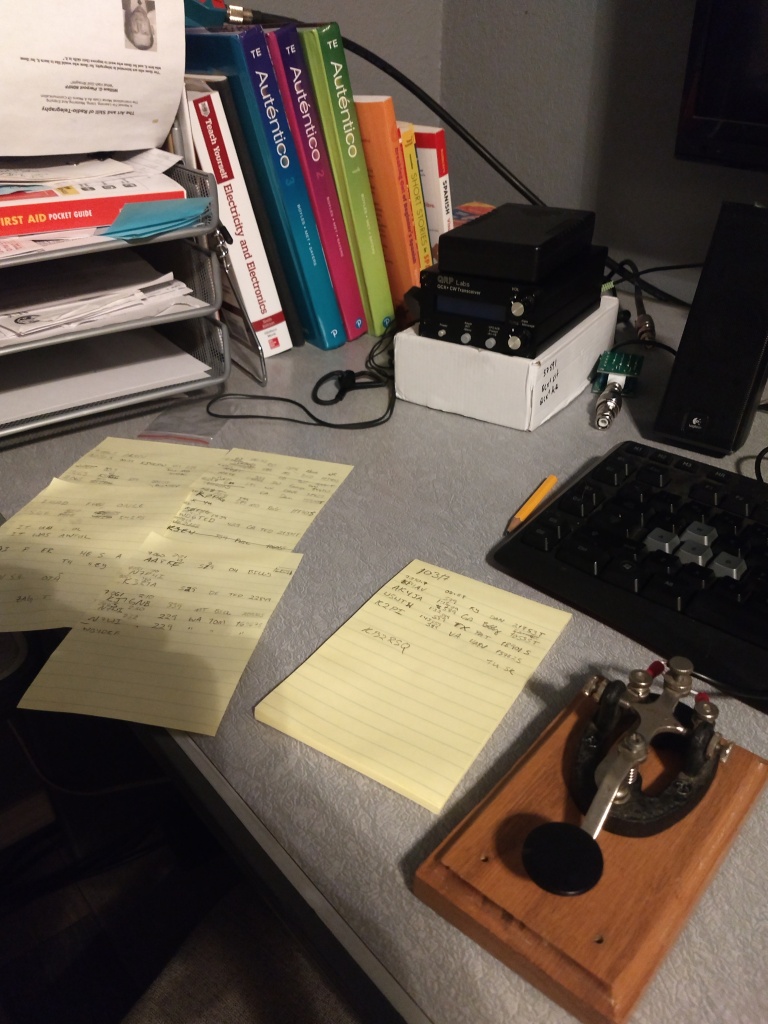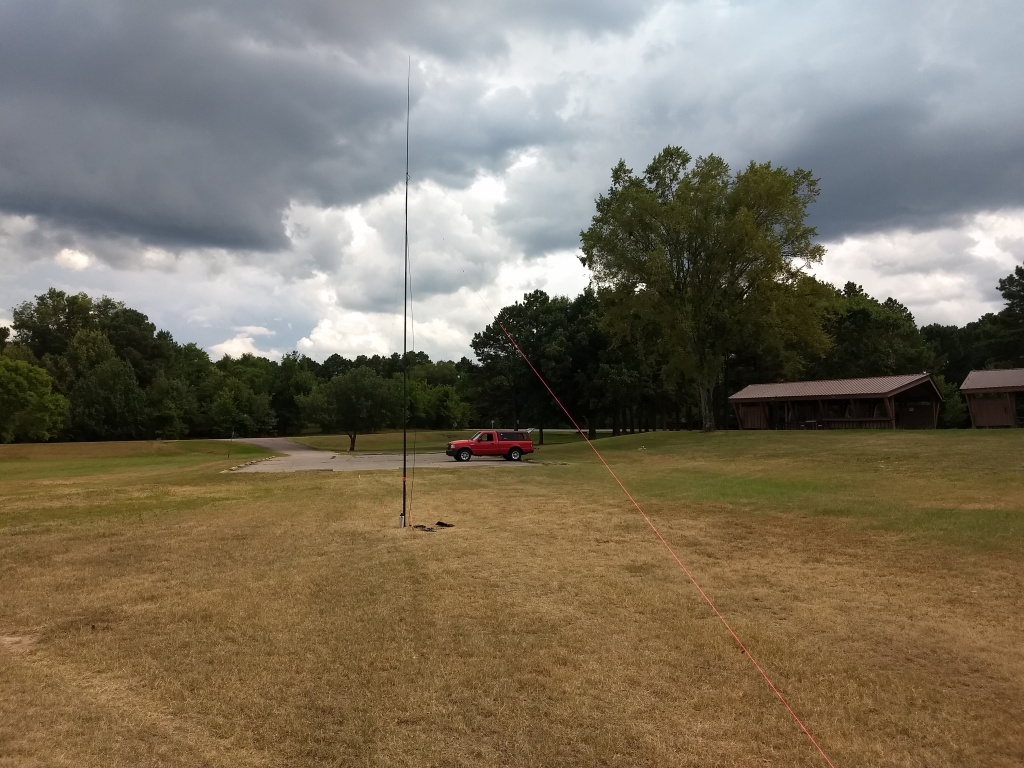Take full advantage of your frequency allocations by operating CW
If you already have a Technician class amateur radio license, you probably already know about your privileges on 70cm, 2m, 6m, and 10m. However, you can also be on 15m, 40m, and 80m as long as you learn Morse code and operate CW.
Get on HF cheaply
It is a common assumption that ham radio is a hobby for those with large amounts of disposable income, which is not without basis in reality. There are many who sink thousands or more into their stations. However, this is not necessary.
Even with a modest cash outlay, it is possible to communicate via amateur radio to other operators located hundreds, even thousands, of miles away if…
- you are willing to build equipment yourself
- you are willing to learn Morse code
- you are willing to operate using low power
…none of which are impediments to enjoying the hobby.
Ethos behind Recommended Equipment
When I created this list, I worked to make a comprehensive gear list that comprised of only necessary items that were of high quality yet were inexpensive.
Basically, I wanted to keep it cheap but not frustratingly so, nor did I want state an initial cost only to surprise you later with additional cash layouts.
The all-in/have-nothing cost comes out to $472 which includes shipping, excludes tax, and assumes you have no access to tools whatsoever. If you are a homeowner with a nice tree and nice neighbors, have a mentor, or frequent a makerspace, your cost will go down.
So there you have it: on the air for less than $500. Less than $400 if you have a good tree. Less than $350 if you know someone with an antenna analyzer. Less than $300 if you have access to a soldering iron.
I gain no commission from any of the links below. They are provided only to help you out.
The Radio, Key, and Power Supply
Which HF band should I first operate on: 15m, 40m, or 80m?
Short answer: 40m.
The 40m band is almost always open to somewhere and the antennas are a manageable size. Plus, there’s a good amount of operators there already who are willing to work beginners.
As the solar cycle picks up, 15m will work better but right now conditions are spotty. Lots of people like 80m, but full sized antennas need to be 125ft long. Plus, 80m generally only works well at night and/or during the winter.
Caveats: you might want to use 15m if you live in the tropics or 80m if up near the poles. However, you should research if this will hold true for your location. 40m still might be the best choice.
QRP Labs QCX+ for 40m
For me, a significant amount of my ham radio fun comes from building the equipment I use. The QCX is an inexpensive yet high quality rig with many features that make for an enjoyable operating experience. Thousands of hams have built this radio and love to use it. It sees almost daily usage in my personal shack.
$55.00 for the radio
$25.00 for the case
$20.00 for shipping to US
If you need to save money, bring your own case, but it is rather handsome and it protects your handiwork.
If you are considering a radio to grow into, look into the LNR Precision MTR3B or the YouKits HB-1B. Both radios have large followings among the QRP/SOTA/POTA crowd.
TalentCell 12v 6ah recharegeable battery
To make things easy, this battery comes with a charger and connection cables to power the QCX without any guesswork. I ran the radio off this battery every day for three weeks before I charged it.
There is a battery for $22 for half the capacity if you need to save money.
If you’re top heavy with rechargeable batteries, consider something like this 8xAA case with a switch. I have not tried this, but it should work.
CW Morse 3D printed Key
If you’ve poked around on the internet, most new keys are expensive. So, I tried making a key that was nice to use but I’m a long way off from creating something that allows me to be accurate and comfortable. Don’t get me wrong, what I’ve made works but it isn’t a quality instrument.
In the interest of keeping costs and frustrations low, I recommend a 3D printed key by CW Morse. It might be worth looking into a larger key with a weighted base as your first key, such as the Camelback Key or the Micro Key. The key I chose, the Nano QRP Key, is the smallest one they make since I want to take it out SOTA/POTAing. The price is right and it works well out of the box, even though I modified it almost immediately.
Camelback Key with Base for $37 plus $7 shipping
Micro Key with Base for $32 plus $7 shipping
Nano QRP Key for $20 plus $7 shipping
You might try asking the SKCC ops who post in groups.io for key recommendations as well. Someone might make you a deal on a key that is almost sure to work well.
My main key is a Speed X straight key which was a gift. It is a joy to use, fast and very adjustable. If you find one that is nice for a reasonable price, get it! It is difficult to get a better key for the money.

The Antenna System
A wonderful first antenna is the dipole in an inverted v configuration. It is hard to beat this simple design in terms of performance, cost, and ease of construction. I have included an antenna mast that will aid in getting your antenna up if trees are not available.
Jackite Pole – 31ft tall
When I operate portable or in someone else’s backyard, this is the pole I use. It is a bit pricey, but there is no comparison between this genuine article and cheaper, shorter, less robust items that can be found on eBay. I went the cheap route first and it wasn’t adequate for stringing up a dipole with even light gauge wire.
If you have large trees, then this mast is unnecessary. Money back in your pocket!
RG58 Coax – 50ft
Gets your signal from your radio to the antenna. The length I chose below is for 50ft, which gets you up the Jackite pole plus some 20-odd feet more to play with. Use the measuring tape that I’ve added below if you’re unsure about which length you need. Less is generally better.
The coax above is nothing special and if you can afford an upgrade, consider this option from DX Engineering that I use.
Polyester Rope – 250ft
As it turns out, rope is not rope. Polyester is more UV resistant and slackens less when wet than other types of rope like nylon and polypropylene, which should be a consideration if your setup is anything permanent. The stuff I got from the store below has worked out great and is cheaper than anything comparable from big box hardware stores. Made in the US.
Tent Stakes
Nothing too special about these. They’re cheap and strong. They’re from Harbor Freight.
$4 for six 10in stakes
Female BNC bulkhead connectors
These connect your coax to your dipole. The ones with the nut can make for a stronger mechanical connection.
$9 for ten on Amazon
Wire – 22 gauge 100 feet
This wire is good stuff for portable operation. I’ve gotten thinner stuff and it is either fidgety or brittle or both.
Stranded house wiring or speaker wire is heavy, but doable, both of which I’ve used with success. I bet if you went to a flea market, I bet you could get wire even cheaper than this.
$11 on Amazon

The Test Equipment, Tools, and Supplies
Multimeter
The meter I use is nothing fancy, just another Harbor Freight special. It will come in handy for checking solder connections on those QCX toroids, building antennas, and checking battery voltages.
$6.50 at Harbor Freight
NanoVNA
The best antennas are resonant ones. This bit of kit helps build as many antennas as you desire, and helps ensure that you have it well positioned when portable.
Some have had problems with getting reliable ones. I got mine from GigaParts just in case I got a bad one. It has served me well for about a year and I don’t know why I waited so long to get one.
If you know another ham with an antenna analyzer, see if they will loan it to you or join you for your antenna building. I bought my NanoVNA after years of borrowing other people’s analyzers.
QRP Labs Dummy Load
Dummy loads are a false antenna that you can transmit into to make sure that your equipment is working properly without interfering with other hams, or anyone else for that matter. If you are inexperienced at soldering, this makes for a good first project. Plus, you end up with a nice bit of test equipment when you’re done.
If you want it, make sure you get it at the same time as the QCX radio so that you save on shipping.
$8.50 on QRP Labs
Soldering Iron
Whenever I decided to get an iron with a thin tip for soldering small stuff, I went the T12 soldering iron route. It’s incredible how it is ready to solder in a matter of seconds. I was used to waiting a couple of minutes before the iron was ready to use.
It is possible to go much cheaper than the one I have chosen, but get one with an adjustable temp. Otherwise, you risk overheating delicate components. Conversely, desoldering is a pain if your iron can’t get hot enough.
Helping Hands or Vice
When soldering, you really do need some way to hold your work as your hands are busy holding the iron and the solder. Luckily, Harbor Freight offers an inexpensive one.
There’s nothing wrong with the cheap helping hands offered by Harbor Freight, but I think you can make a better set yourself.
Wire Strippers and Cutters
Although these wire cutters are from Harbor Freight, they are as good as some of the name brand tools out there.
The ones that are generally included with crimping kits aren’t very good. The cutters don’t align together well which makes for sloppy work.
Small Screwdriver Set
When working with kits, there’s always an enclosure to put together or standoffs to add to PCBs. Don’t risk stripping the small screws with drivers that are too large.
165′ measuring tape
A long measuring tape makes your antenna work efficient. It helps you measure your wire, your rope, and your area where you plan to get the wire in the air. This one is long enough to measure out areas for 80m if/when you choose to get a rig for that band.
*This is your most expensive Harbor Freight item. Use that 20% off coupon!
Solder and Flux
Good Kester solder is more expensive but it makes your work cleaner. I have used the cheap stuff. It really isn’t as good.
$11 for a little $30 for a lot
Flux paste also makes kit building neater. I used to not use it, but now I’m glad I do. It prevents the bad joints I used to make.
Desoldering Pump and Braid
Mistakes are inevitable. They don’t have to be permanent if you have a braid to wick the reheated solder away and a pump to get the rest of it out. It seems like an extra, but you won’t regret having it when the time comes…and it will.
I sincerely hope that you see this list as a feasible way to get on HF with a little bit of cash.